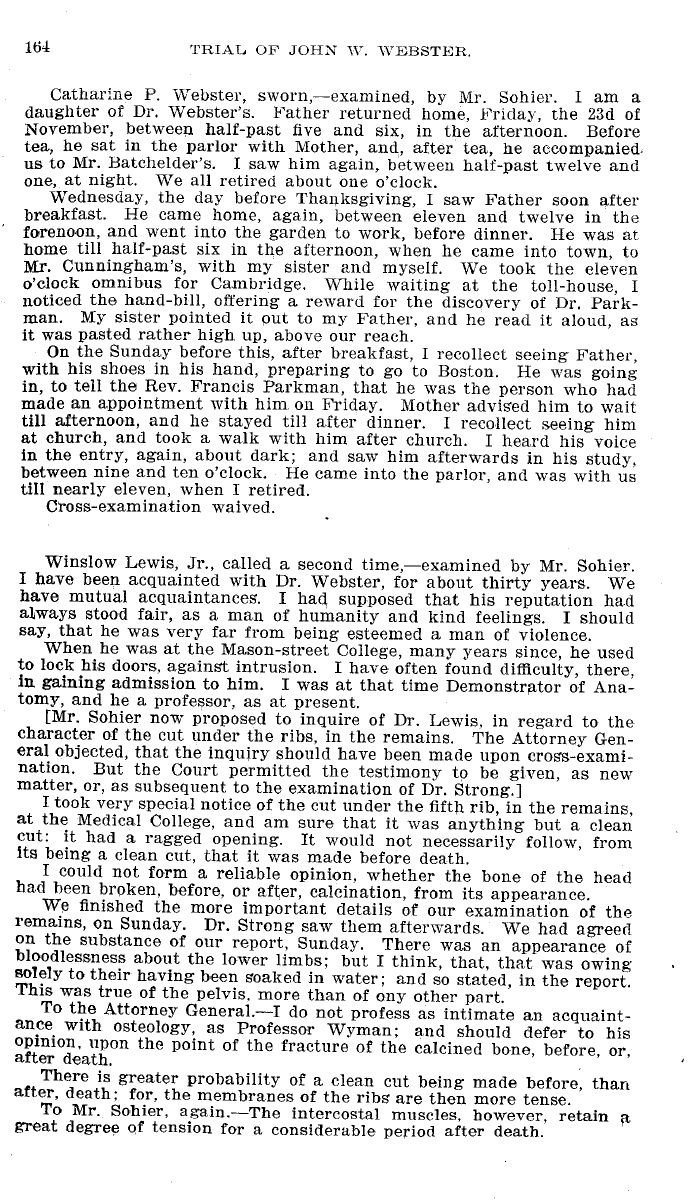|
164 TRIAL OF JOHN \\'. WEBSTER.
Catharine P. Webster, sworn,-examined, by Mr. Sohier. I am a
daughter of Dr. Webster's. Father returned home, Friday-, the 23d of
November, between half-past five and six, in the afternoon. Before
tea, he sat in the parlor with Mother, and, after tea, he accompanied,
us to Mr. Batchelder's. I saw him again, between half-past twelve and
one, at night. We all retired about one o'clock.
Wednesday, the day before Thanksgiving, I saw Father soon after
breakfast. He came home, again, between eleven and twelve in the
forenoon, and went into the garden to work, before dinner. He was at
home till half-past six in the afternoon, when he came into town, to
Mr. Cunningham's, with my sister and myself. We took the eleven
o'clock omnibus for Cambridge. While waiting at the toll-house, I
noticed the hand-bill, offering a reward for the discovery of Dr. Park-
man. My sister pointed it out to my Father, and he read it aloud, as
it was pasted rather high up, above our reach.
On the Sunday before this, after breakfast, I recollect seeing Father,
with his shoes in his hand, preparing to go to Boston. He was going
in, to tell the Rev. Francis Parkman, that he was the person who had
made an appointment with him, on Friday. Mother advised him to wait
till afternoon and he stayed till after dinner. I recollect seeing him
at church, and took a walk with him after church. I heard his voice
in the entry, again, about dark and saw him afterwards in his study,
between nine and ten o'clock. He came into the parlor, and was with us
till nearly eleven, when I retired.
Cross-examination waived.
Winslow Lewis, Jr., called a second time,-examined by Mr. Sohier.
I have been acquainted with Dr. Webster, for about thirty years. We
have mutual acquaintances. I had supposed that his reputation had
always stood fair, as a. man of humanity and kind feelings. I should
say, that he was very far from being esteemed a. man of violence.
When he was at the Mason-street College, many years since, he used
to lock his doors, against intrusion. I have often found difficulty, there,
in gaining admission to him. I was at that time Demonstrator of Ana-
tomy, and lie a professor, as at present.
[Mr, Sohier now proposed to inquire of Dr. Lewis, in regard to the
character of the cut under the ribs, in the remains. The Attorney Gen-
eral objected, that the inquiry should have been made upon cross-exami-
nation. But the Court permitted the testimony to be given, as new
matter, or, as subsequent to the examination of Dr. Strong.]
I took very special notice of the cut under the fifth rib, in the remains,
at the Medical College, and am sure that it was anything but a clean
cut: it had a ragged opening. It would not necessarily follow, from
its being a clean cut, that it was made before death.
I could not form a reliable opinion, whether the bone of the head
had been broken, before, or after, calcination, from its appearance.
We finished the more important details of our examination of the
remains, on Sunday. Dr. Strong saw them afterwards. We had agreed
on the substance of our report, Sunday. There was an appearance of
bloodlessness about the lower limbs; but I think, that, that was owing
solely to their having been soaked in water; and so stated, in the report.
This was true of the pelvis, more than of any other part.
To the Attorney General.-I do not profess as intimate an acquaint-
ance with osteology, as Professor Wyman; and should defer to his
opinion, upon the point of the fracture of the calcined bone, before, or,
after death.
There is greater probability of a clean cut being made before, than
after, death for, the membranes of the ribs are then more tense.
To Mr. Sohier, again.-The intercostal muscles, however, retain
great degree of tension for a considerable period after death.
|

